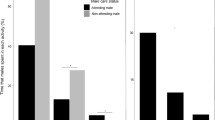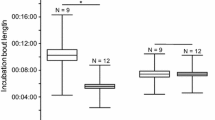Abstract
Predation is one of the main drivers of behavioral adaptation in prey. In species with parental care, predation can affect survival of both adults and the offspring under their care. This effect can be further modulated by or combined with other factors that contribute to mating and reproductive success of adults, such as the quality of their breeding site. Using the nest guarding behavior of a treefrog with paternal egg attendance, Kurixalus eiffingeri, we quantify the effects of predation on the behavior of adult frogs and the survival of their offspring. We observed predator avoidance behavior of male frogs guarding empty breeding sites or breeding sites with eggs in response to the introduction of a predatory snake, Dinodon rufozonatum. We hypothesized that male nest guarding behavior would be negatively correlated with predation risk and positively correlated with their clutch sizes. Furthermore, we predicted that predator avoidance in male frog would negatively impact the survivorship of their offspring. We found that breeding site fidelity in male frogs was determined by perceived predation risk and breeding site value, with more males abandoning sites when exposed to high mortality risks (presence of a snake) and when the reproductive benefits (number of offspring) were low. In addition, we found that the willingness of males to return to their breeding sites was positively correlated with their clutch sizes. Abandoning breeding sites, however, can be costly to males, because abandoned eggs had a lower hatching rate. Our findings provide empirical evidence of how the costs and benefits of predation risk and breeding site value can determine the behavior of an amphibian with parental care.
Significance statement
When faced with predation risks, the willingness of individuals to maintain their ownership over nest sites can have significant effects on their reproductive success. For species with parental care, nest defense can also be critical for offspring survival. Using an East Asian treefrog with male egg attendance, we hypothesized that males would maximize their reproductive output by increasing investment for nest sites with low predation risks and with more offspring. We found that males are more likely to invest in nest attendance when risks are low and benefits of offspring survival are high. Moreover, we found that the willingness of males to continue parental investment resulted in an increase in survivorship of their offspring. Our results show that perceived risks and benefits to the adults are important factors in determining offspring survival in an amphibian species with parental care.





Similar content being viewed by others
References
Baker JMR (1992) Body condition and tail height in great crested newts, Triturus cristatus. Anim Behav 43:157–159
Basso A, Richner H (2015) Effects of nest predation risk on female incubation behavior and offspring growth in great tits. Behav Ecol Sociobiol 69:977–989
Beletsky LD, Orians GH (1987) Territoriality among male red-winged blackbirds. 1. Site fidelity and movement patterns. Behav Ecol Sociobiol 20:21–34
Bourne GR (1998) Amphisexual parental behavior of a terrestrial breeding frog Eleutherodactylus johnstonei in Guyana. Behav Ecol 9:1–7
Caro T (2005) Antipredator defenses in birds and mammals. University of Chicago Press, Chicago
Chen Y-H, Yu H-T, Kam Y-C (2007) The ecology of male egg attendance in an arboreal breeding frog, Chirixalus eiffingeri (Anura: Rhacophoridae), from Taiwan. Zool Sci 24:434–440
Chen Y-H, Cheng W-C, Yu H-T, Kam Y-C (2011) Genetic relationship between offspring and guardian adults of a rhacophorid frog and its care effort in response to paternal share. Behav Ecol Sociobiol 65:2329–2339
Cheng W-C, Kam Y-C (2010) Paternal care and egg survivorship in a low nest-attendance rhacophorid frog. Zool Stud 49:304–310
Consolmagno RC, Requena GS, Machado G, Brasileiro CA (2016) Costs and benefits of temporary egg desertion in a rocky shore frog with male-only care. Behav Ecol Sociobiol 70:785–795
Dassow JA, Eichholz MW, Stafford JD, Weatherhead PJ (2012) Increased nest defence of upland-nesting ducks in response to experimentally reduced risk of nest predation. J Avian Biol 43:61–67
Delia JRJ, Ramirez-Bautista A, Summers K (2013) Parents adjust care in response to weather conditions and egg dehydration in a Neotropical glassfrog. Behav Ecol Sociobiol 67:557–569
Dugas MB, Wamelink CN, Killius AM, Richards-Zawacki CL (2016) Parental care is beneficial for offspring, costly for mothers, and limited by family size in an egg-feeding frog. Behav Ecol 27:476–483
Ghalambor CK, Martin TE (2000) Parental investment strategies in two species of nuthatch vary with stage-specific predation risk and reproductive effort. Anim Behav 60:263–267
Ghalambor CK, Peluc SI, Martin TE (2013) Plasticity of parental care under the risk of predation: how much should parents reduce care? Biol Lett 9:20130154
Hawlena D, Schmitz OJ (2010) Physiological stress as a fundamental mechanism linking predation to ecosystem functioning. Am Nat 176:537–556
Huang W-S, Pike DA (2013) Testing cost-benefit models of parental care evolution using lizard populations differing in the expression of maternal care. PLoS One 8:e54065
Kam Y-C, Chuang Z-S, Yen C-F (1996) Reproduction, oviposition-site selection, and tadpole oophagy of an arboreal nester, Chirixalus eiffingeri (Rhacophoridae), from Taiwan. J Herpetol 30:52–59
Kight SL, Tanner AW, Coffey GL (2011) Termination of parental care in male giant waterbugs, Belostoma flumineum Say (Heteroptera: Belostomatidae) is associated with breeding season, egg pad size, and presence of females. Invertebr Reprod Dev 55:197–204
Kundey SMA, Millar R, McPherson J, Gonzalez M, Fitz A, Allen C (2016) Tiger salamanders’ (Ambystoma tigrinum) response learning and usage of visual cues. Anim Cogn 19:533–541
Lehtonen TK, Lindström K, Wong BBM (2013) Effect of egg predator on nest choice and nest construction in sand gobies. Anim Behav 86:867–871
Lemos F, Sarmento RA, Pallini A, Dias CR, Sabelis MW, Janssen A (2010) Spider mite web mediates anti-predator behaviour. Exp Appl Acarol 52:1–10
Lin Y-S, Lehtinen RM, Kam Y-C (2008) Time-and context-dependent oviposition site selection of a phytotelm-breeding frog in relation to habitat characteristics and conspecific cues. Herpetologica 64:413–421
Lindström K, Pampoulie C (2005) Effects of resource holding potential and resource value on tenure at nest sites in sand gobies. Behav Ecol 16:70–74
Low M, Makan T, Castro I (2012) Food availability and offspring demand influence sex-specific patterns and repeatability of parental provisioning. Behav Ecol 23:25–34
Martin T, Briskie J (2009) Predation on dependent offspring: a review of the consequences for mean expression and phenotypic plasticity in avian life history traits. Ann N Y Acad Sci 1168:201–217
McKeon CS, Summers K (2013) Predator driven reproductive behavior in a tropical frog. Evol Ecol 27:725–737
Pechenik JA, Wendt DE, Jarrett JN (1998) Metamorphosis is not a new beginning. Bioscience 48:901–910
Perry G, Wallace MC, Perry D, Curzer H, Muhlberger P (2011) Toe clipping of amphibians and reptiles: science, ethics, and the law. J Herpetol 45:547–555
Poo S, Bickford DP (2013) The adaptive significance of egg attendance in a South-East Asian tree frog. Ethology 119:671–679
Poo S, Evans TA, Tan MK, Bickford DP (2016a) Dynamic switching in predator attack and maternal defence of prey. Biol J Linn Soc 118:901–910
Poo S, Low M-R, Devan-Song A (2016b) Xenochrophis flavipunctatus (Yellow-spotted Keelback Watersnake). Diet Herpetol Rev 47:319
Royle NJ, Smiseth PT, Kölliker M (2012) The evolution of parental care. Oxford University Press, Oxford
Semlitsch RD, Scott DE, Pechmann JHK (1988) Time and size at metamorphosis related to adult fitness in Ambystoma talpoideum. Ecology 69:184–192
Shang K-S, Yang Y-J, Li P-H (2009) Field guide to amphibians and reptiles in Taiwan (in Chinese). Owl Publishing House Co, Taipei
Smiseth PT, Kölliker M, Royle NJ (2012) What is parental care? In: Royle NJ, Smiseth PT, Kölliker M (eds) The evolution of parental care. Oxford University Press, Oxford, pp 1–17
Stancher G, Rugani R, Regolin L, Vallortigara G (2014) Numerical discrimination by frogs (Bombina orientalis). Anim Cogn 18:219–229
StatSoft (2011) STATISTICA (data analysis software system), version 10, http://www.statsoft.com
Stearns SC (1992) The evolution of life histories. Oxford University Press, Oxford
Toledo LF, Sazima I, Haddad CFB (2011) Behavioural defences of anurans: an overview. Ethol Ecol Evol 23:1–25
Travers M, Clinchy M, Zanette L, Boonstra R, Williams TD (2010) Indirect predator effects on clutch size and the cost of egg production. Ecol Lett 13:980–988
Trivers RL (1972) Parental investment and sexual selection. In: Cambell B (ed) Sexual selection and the descent of man. Aldine, Chicago, pp 136–179
Valencia LB, Delia J (2016) Maternal care in a glassfrog: care function and commitment to offspring in Ikakogi tayrona. Behav Ecol Sociobiol 70:41–48
Vockenhuber EA, Hodl W, Amezquita A (2009) Glassy fathers do matter: egg attendance enhances embryonic survivorship in the glass frog Hyalinobatrachium valerioi. J Herpetol 43:340–344
Wells KD (2007) The ecology and behavior of amphibians. University Of Chicago Press, Chicago
Wisenden BD, Snekser JL, Stumbo AD, Leese JM (2008) Parental defence of an empty nest after catastrophic brood loss. Anim Behav 76:2059–2067
Zanette LY, White AF, Allen MC, Clinchy M (2011) Perceived predation risk reduces the number of offspring songbirds produce per year. Science 334:1398–1401
Acknowledgments
We would like to thank Chaun-Bin Cheng, Nien-Tse Fuh, Xiang-Yu Gu, Jia-Jiun Hu, Yu-Chen-Hsi Huang, Chieh-Jen Kuo, Yo-Wei Lin, Shao-Wei Peng, Wen-Yu Shiu, and Xin-Yi Wei for their assistance with fieldwork at Chitou. We thank the College of Bio-Resources, National Taiwan University, for permission to carry out our study. Finally, we would like to thank Dr. Glauco Machado and an anonymous reviewer for their thoughtful comments, which have helped improve this manuscript. This work was supported by the Ministry of Science and Technology grants to YCK (MOST 105-2621-B-029-004-MY2).
Author information
Authors and Affiliations
Corresponding authors
Ethics declarations
Ethical approval
All research presented in this manuscript was conducted in accordance with ethical standards of Tunghai University and was approved by the Institutional Animal Care and Use Committee of Tunghai University (No. 100-19). Experiments at Chitou were approved by the College of Bio-Resources and Agriculture, National Taiwan University (Document No. 1030006132).
Conflict of interest
The authors declare that they have no conflict of interest.
Data availability
All data generated and analyzed during this study are included in the supplementary information file of this published article (Supplementary File 1).
Additional information
Communicated by C. R. Gabor
Electronic supplementary material
Supplementary File 1
(XLSX 16 kb).
Rights and permissions
About this article
Cite this article
Chuang, MF., Lee, WH., Sun, JS. et al. Predation risk and breeding site value determine male behavior and indirectly affect survivorship of their offspring. Behav Ecol Sociobiol 71, 122 (2017). https://doi.org/10.1007/s00265-017-2349-6
Received:
Revised:
Accepted:
Published:
DOI: https://doi.org/10.1007/s00265-017-2349-6




